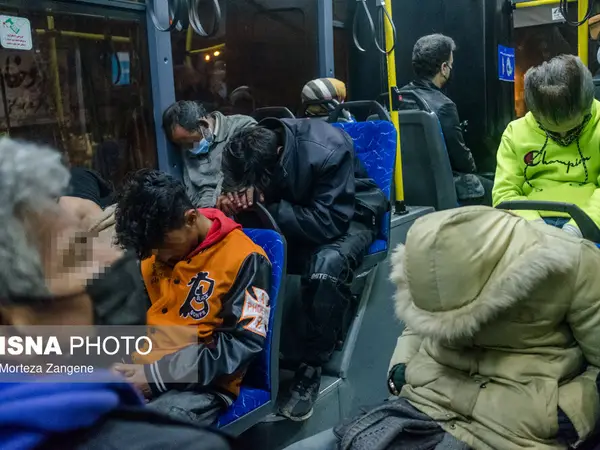Controversies over "night bus sleepers" and whether to allow people to sleep on city buses have deepened in Iran, as high inflation impoverishes more people.
A photo report headlined "The Night Bus" published by the Iranian Students News Agency(ISNA) has heightened the issue of homeless people sleeping on Tehran buses.
Most are not drug addicts, the report said Saturday, and were people who work but cannot afford the cheapest guesthouses as accommodation. The night bus sleepers told ISNA that buses offered the chance for a few hours’ secure sleep away from shelters they found unsanitary and unsafe. Some said they always sleep in buses.
Ahmad Alavi, a member of Tehran City Council, told ISNA Sunday that municipality officials were aware that night bus sleepers were different from the “typical” homeless who were often addicted to drugs and frequented homeless shelters.
Social media activists responded to the report by suggesting mosques should open their doors for rough sleepers on cold winter nights, while hardliners who control the government and religious institutions opposed the idea on grounds that mosques should be used strictly for religious purposes. Mosques were not "dormitories," tweeted Abdollah Ganji, editor-in-chief of Javan newspaper, affiliated with the Revolutionary Guard.
In response, social media users said mosques are being used for state propaganda and housing the Basij, the paramilitary arm of the Revolutionary Guards, and even for economic activities such as cryptocurrency mining which is much cheaply done in mosques due to the special rates they pay for electricity.
There are around 2,000 mosques in Tehran alone. According to Tehran Municipality, Tehran had around 130,000 homeless last year while shelters could only accommodate around 3,000.
Adding to the media hubbub, Mehdi Chamran, conservative chairman of Tehran City Council, said Tuesday he had asked the mayor, Alireza Zakani, to stop people sleeping on buses and to find other accommodation. He said foreign media running the story had “forgotten how garbage scavengers live in London or other places."
Living costs, particularly housing, have risen sharply in Tehran, which according to the Economist's 2021 index of worldwide cost of living jumped from 106th in 2019 to 29th in 2021. The EIU attributed the rise to “continued supply-side constraints, goods shortages and rising import prices following the reimposition of US sanctions.” The EIU ranked Tel Aviv as the most expensive city in the world, followed by Paris.
According to a report by EcoIraneconomic website published January 3, the index for ‘misery’ – adding the unemployment rate to inflation – rose 20 points to 55 points in the twelve months leading to September 2021.
The increase results entirely from rising inflation as government figures, on which the EcoIran report was based, show a fall in unemployment from around 12 percent in summer 2020 to 9.6 percent in 2021.Economists say the figuredoes not include those losing work during the pandemic, and that the government-run Iran Statistical Center considers anyone who has worked for at least one hour a week to be employed. According to ISC,unemployment is at the lowest levelsince 1996, with the center highlighting “the spread of the coronavirus disease which has caused many young adults to leave the labor market.”
The Washington-based conservative Cato Institute, committed to ‘libertarian’ economics, ranked Iran 8th in the world in its Hanke's 2020 Annual Misery Index, with Venezuela as the world’s most miserable country.
